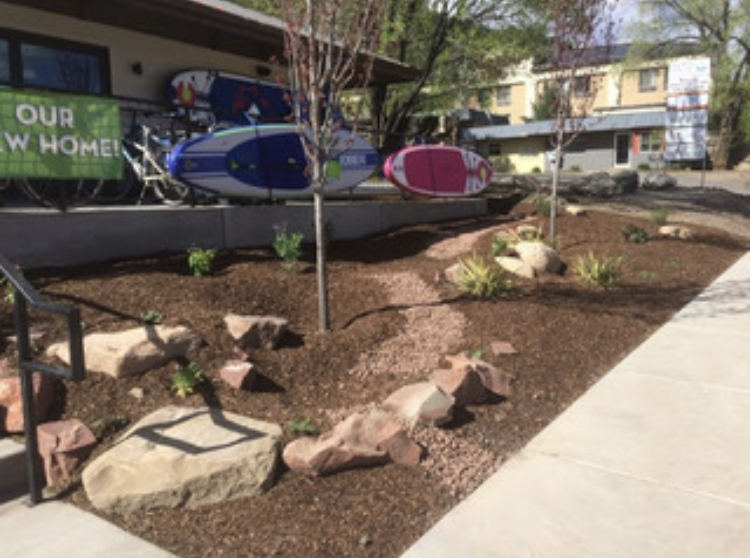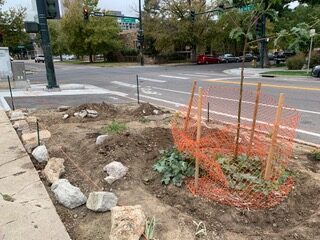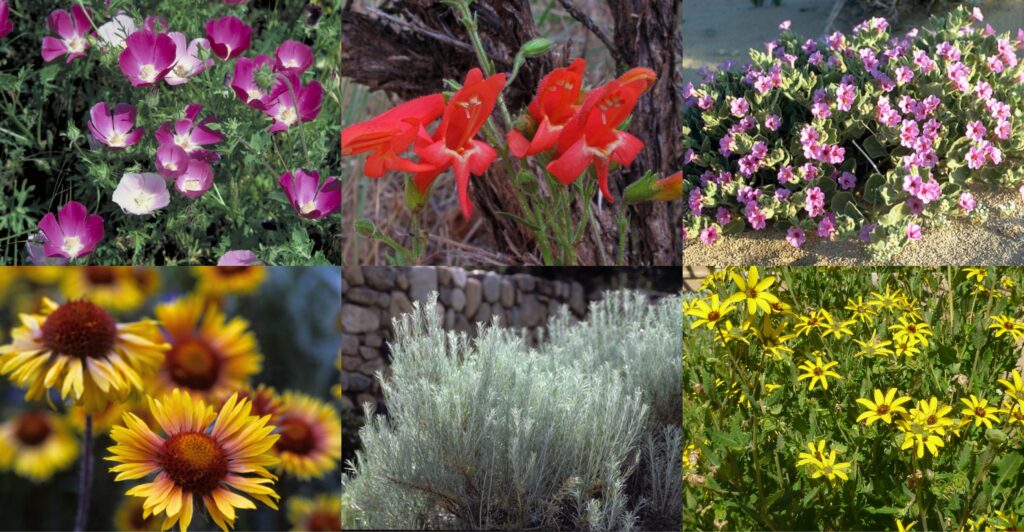By Deb Lebow Aal
In July, 2021, we reprinted an article from Harlequin Gardens on tips and tricks to water less. We’d like to highlight some of those tricks, again, add to them, and update some ideas from that article.
That article focused on the advantages of xeriscaping your landscape; we’ve moved away from that term, and prefer the term “Coloradoscape.” Not only do you want plants that use less water, you want plants that belong here. Our native plants will get you so much more in terms of ecosystem benefits than non-native plants. So, let’s Coloradoscape from now on.
We all know that we need to use less water here in the western U.S. Those thirsty Kentucky Bluegrass lawns have a purpose, but should for the most part be a thing of the past. There is so much of it still out there – a very old estimate is 40 million acres in the lower 48. We also know we’ve been in a megadrought in the western U.S., although the past two years have been a bit kinder to us. Here on the Front Range, we still use 55 percent of our water for outdoor landscapes. That’s a lot. And, those of you who know water usage will say “but 85 percent of our water in Colorado is used in agriculture.” Well, yes, but we do need to eat. (Granted, we don’t need all that alfalfa if we don’t feed so many cows, but that’s a very different discussion…) We don’t eat our lawns.
A water smart design conserves more than water. It conserves resources. Consider how that water got to your house. It required transporting a long way and pumping to your water provider. That’s a fair amount of electricity usage. A true ecologically sound landscape will use as little of this precious resource as possible.
Here are some things to think about as you ponder watering your outdoor landscape less.
“Plant the Water” first: A garden that captures, holds, and stores water is what you want. How does one do that? We will have a different article on rainwater harvesting, but contouring your landscape to catch water and direct it to where you want it to go is the principle. This does not only result in reducing water needs, but also can provide visual interest. If you are lucky enough to be starting from scratch, this is one of the first things you should do.

But, if you’re not starting with a blank scape, what do you do? You can put in smaller channels, and create wells around your plants, so that they individually collect water when provided.

Build Your Soil: Soil with high organic matter holds a fair amount of water. The organic matter acts like a sponge when water is present. There is research out there showing that soil with as little as 2 percent organic matter can reduce irrigation needs by 75 percent when compared to poor soils (soil with less than 1 percent organic matter). Soil that is aerated, i.e., not compacted, will also hold more water. So, be careful where you’re stepping. Stay on your paths, and take care of your soil. Note, though, that for native plants, we don’t advise adding fertilizers or additives. Just top dressing occasionally with compost, and, again, stay on your paths.
Reduce your lawn area: You can do this a little at a time. Keep adding to your native plant beds around the edges. I lived in a duplex townhome where we took the lawn out on both sides at the same time, and planted native plants. My neighbors were astounded at how much water we both saved. At Depot Park in Englewood, where the grass was removed and native plants were planted, the city reduced its water usage there by 70 percent. You can and should do this a little at a time. Or, better yet, instead of the default being great expanses of turf, have that turf (preferably not Kentucky bluegrass) be your walkways.
Shade equals water: You’ll notice in your own landscapes that areas under trees are often greener than areas not shaded. Plants like poppy mallow, (Callirhoe involucrata), a very drought tolerant plant highlighted this month in our plant spotlight, will look more vibrant and bloom more in partial or dappled shade. That’s true of many of our xeric native plants.
Wind protection: Wind can suck the water right out of a plant, so, a wind break or fence equals more water. That area protected from the wind will need less water.
Nurse plants: We’ve all seen this – a new plant shaded by another more mature plant, thriving, while another planted in an open area, wilting. I’ve used this practice – placing a new plant under the guidance of a larger plant – when planting in the heat of the summer. Again, shade equals water.
Mulch: Mulch keeps the water in the ground from drying out. In studies done, pea gravel makes a really good mulch for keeping roots cool and dry, resulting in less water needed for the plants. The top of the rocks of course gets hot, but underneath, it stays cool (this is not true when you use larger rock). Organic mulches get hot too, do not keep the roots of your plants cool and dry, but are still better than bare dirt. And, of course, green mulches are great – plant your plants densely to reduce water usage! See our mulch article.
Ollas: I’ve never tried this, but burying earthenware clay pots in your garden, and letting those pots water your garden can reduce your water usage significantly. This concept goes back thousands of years and has been used by many cultures. An olla watering system is an osmosis system. You bury an unglazed clay pot, with a small amount left above the surface, fill it with water, place a lid on it. As the water leeches out of the pores of the pot, it slowly waters the soil and roots of your plants.
Cover your ground with plants: We’ve already said this, but it bears repeating. Bare soil will dry out much faster than soil protected by plants. So, plant densely. Leave a little bare soil for our ground-nesting bees (there are a lot of them), but otherwise, your best bet is to have many plants covering your landscape.
Dead heading (especially in July and August): Deadheading right after flowering and before the plant sets seed allows the plant a little energy respite. The plant will require less water and have a longer life.
Planting with rocks equals water: When you’re out hiking, have you noticed those amazing plants creeping out from beneath a rock? They’re growing there because, not in spite of, that rock. Our cool Colorado nights allow water to condense and run under the rocks.It is cool and wet under there. A plant next to a rock or between rocks often thrives where the same plant out in the open, will struggle. Rock gardens and crevice gardens use this technique, burying stones at least half underground. The roots thrive in a moister, cooler, environment.
Low water annuals: Fill bare spots with some low water annuals. We don’t have a lot of native annuals I can recommend, but some favorites are prickly poppy (Argemone polyanthemos), California poppies (sort of a regional native?), and cornflower. I use blue flax (Linum lewisii) as an annual, even though it is not. It is such a good self-seeder – and then you have that pop of bright blue where you want it.
Deep, infrequent watering: Instead of watering three times a week, like many do with a lawn, water once every two weeks, with a very deep, long watering. If we did the math, I am sure you could cut your water use in half, and many of your native plants will be happier. Your lawn, probably not.

And, finally, a list of our favorite perennial native plants that need very little water (all pictured in collage above): Callirhoe involucrata (Poppy Mallow) Berlandia lyrata (Chocolate Flower,) Gaillardia aristata (Blanketflower), Pensetemon rostrifolorus or Penstemon bridgesii (Bridges Penstemon), Ericameria nauseosa (Dwarf Rabbit Brush), and Mirabilis multiflora (Desert Four O’clock). That’s just a few very common native plants for our region. We have many more lists of plants in our toolkit.
We could set as our goal watering half as much as we did last year. If you know how much water you used last July and August, see if you can achieve a healthy garden using half that much. We should be designing water into our garden, just as we design our plants, and not as an add on later. A well-thought out water plan will help your garden thrive.
